It is no secret to any fruit grower that the area planted with cherries in Chile has significantly increased over the last decade, with just over 7,000 hectares in 2004 (Smart Cherry 2023) and between 2022 and 2023 more than 62,000 hectares (figure 1), or 67,000 hectares according to other sources. This growth is observed at an annual rate of 6,000-7,000 ha/year.
In the near future, a steady annual growth is expected, similar to recent seasons, with a large number of plants entering production, according to reports from various nurseries and associations. Exports have reached a volume of over 412,000 tons of fresh fruit in the 2023/24 season (iQ, 2024), with China as the main market, accounting for over 90% of exports.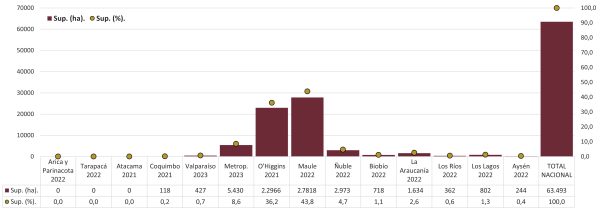 Image 1: Regional and national cherry area in Chile.
Image 1: Regional and national cherry area in Chile.
The high volume of fruit harvested annually in recent seasons has led to the accumulation of raw material in storage rooms, with some packinghouses facing more than 10 days of waiting before processing, at the expense of the product's quality. To address this situation, the use of storage technologies to maintain the initial quality of the fruits has been proposed.
One of the systems tested on a smaller scale is the use of controlled atmosphere (CA) in various combinations, as the reduction of oxygen (O2) and increase in carbon dioxide (CO2) play a key role in the fruit's metabolism, through the respiratory process.
Several studies have evaluated different concentrations of these gases: 2/0, 2/10, 5/10, 5/15, 10/10, 10/15 of O2 and CO2, respectively, in various varieties. These studies have shown a positive effect on some important quality parameters, such as maintaining the firmness and green color of the stem, reducing certain skin blemishes and decay.
Based on the above, it was decided to conduct a study on the effect of this storage system on five cherry varieties, harvested during the commercial harvest of each orchard.
Experiment Description
To partially respond to the effect that the controlled atmosphere would have on the fruits, the Pomacee Center, through its Post-Harvest Unit, has been conducting research since 2021 to determine its impact on fruit firmness, soluble solids, titratable acidity, and post-harvest alterations (which we will address in a future issue) in cherries cv. Lapins, Regina, Sentennial, Staccato, and Sweetheart.
To this end, the fruits were harvested from orchards in the Maule region, following the export criteria required by the industry, and immediately subjected to low temperatures through hydrocooling.
Once the pulp reached 2°C, the crates were wrapped in a 0.3% perforated bag (cap) and stored in controlled atmosphere chambers (Image 2) where the gas concentration was adjusted, reaching 10% O2 and 8% CO2 at a storage temperature between -0.5 and 0.0°C.
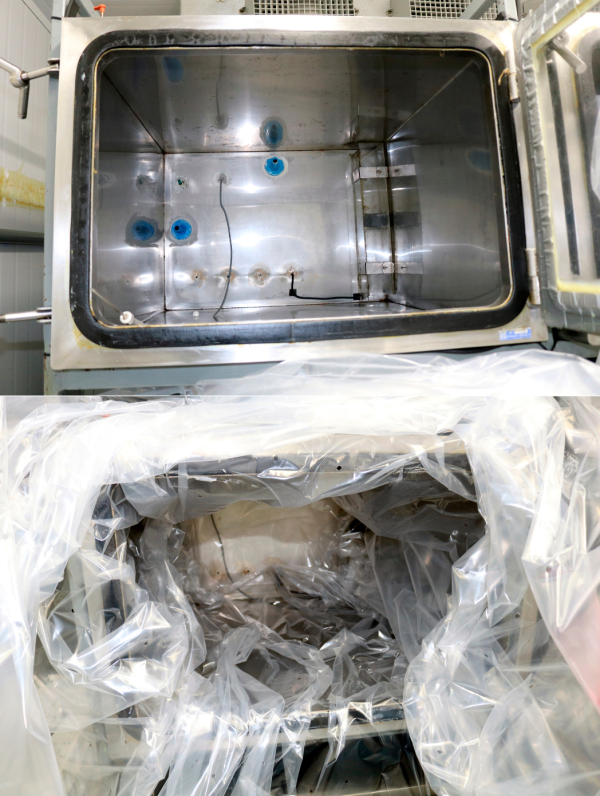 Image 2: Controlled atmosphere chambers (Pomacee Center) with perforated bag for cherry storage.
Image 2: Controlled atmosphere chambers (Pomacee Center) with perforated bag for cherry storage.
Additionally, a control sample was stored in modified atmosphere (MA) at the same temperature. Four evaluation moments of maturity indices per cultivar were considered. One initial evaluation at the time of fruit harvest, and subsequent evaluations after storage, simulating the journey to the destination.
To observe the effect of CA, the chosen maturity parameters were fruit firmness (Table 1), soluble solids concentration (Table 2), and titratable acidity (Table 3), both at harvest and after removal from each cold storage.
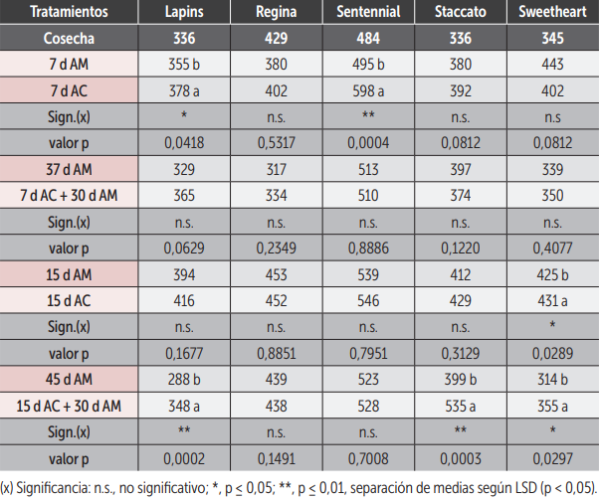 Table 1: Flesh firmness (FirmTech: g/mm) of various cherry cultivars after each storage exit (MA/CA) plus 30 days in MA.
Table 1: Flesh firmness (FirmTech: g/mm) of various cherry cultivars after each storage exit (MA/CA) plus 30 days in MA.
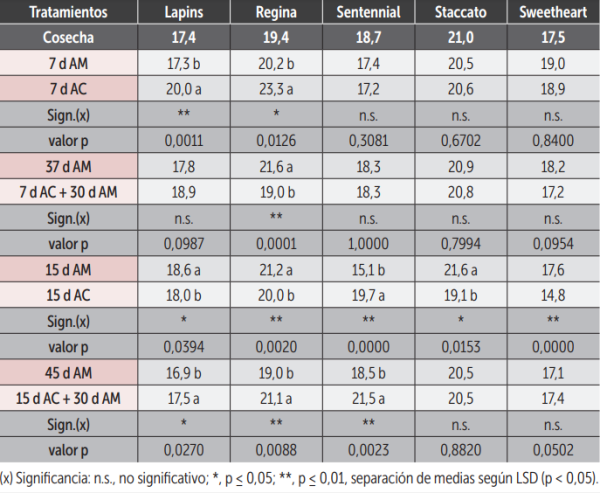 Table 2: Soluble solids (°Brix) in various cherry cultivars after each storage exit (MA/CA) and their stay in MA for 30 days.
Table 2: Soluble solids (°Brix) in various cherry cultivars after each storage exit (MA/CA) and their stay in MA for 30 days.
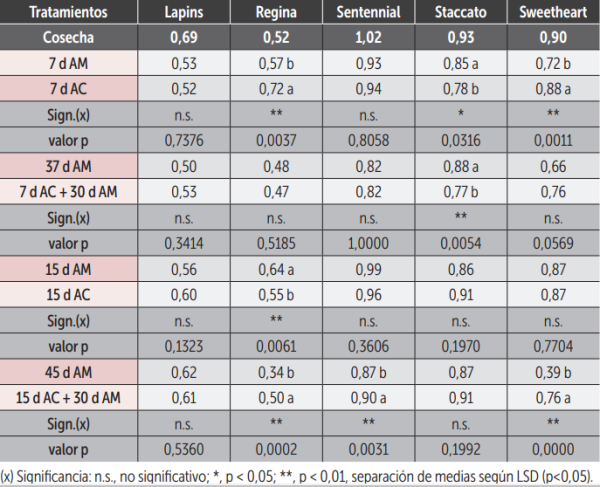 Table 3: Titratable acidity (% malic acid) in various cherry cultivars after each storage (MA/CA) and their stay in MA for 30 days.
Table 3: Titratable acidity (% malic acid) in various cherry cultivars after each storage (MA/CA) and their stay in MA for 30 days.
Fruit Firmness
In the Lapins cultivar, fruits stored in CA showed greater firmness (g/mm, Table 1) in all evaluations compared to fruits stored only in MA; after 7 and 15 days (d) of storage, fruits stored in CA showed 6.5% and 6.6% greater firmness, respectively, compared to those stored in MA for the same time period.
Analyzing the combination of 7 d in CA + 30 d in MA vs. 37 d in MA, it was observed that the combination of both storage systems showed 10.9% greater firmness; while fruits stored for 15 d in CA + 30 d in MA showed 20.8% greater firmness compared to fruits stored for 45 d in MA.
In the case of Regina, no statistical differences were observed between fruits stored in MA and those in CA; however, fruits stored for 7 d in CA and the combination of 7 d in CA + 30 d in MA showed 5.8% and 5.4% greater firmness, respectively, compared to fruits stored only in MA during the same period. As for the cv. Sentennial, it showed differences only in fruits stored for 7 d in CA and MA.
The former reached 20.8% greater firmness compared to the latter, demonstrating the positive effect of CA after 7 days of storage. Although there were no statistical differences on subsequent dates and combinations, a slight tendency to show a higher value in fruits stored in CA emerged.
The cv. Staccato showed a significant difference in the combination of 15 d in CA + 30 d in MA, reaching 34% greater firmness compared to fruits stored for 45 d in MA.
In the cv. Sweetheart, the combination of 15 days in CA + 30 days in MA produced 13% greater firmness compared to fruits stored only in MA for the same time period. Although there are evaluations where no statistically significant differences were found, a tendency to show greater firmness in fruits stored in CA was noted.
Soluble Solids Concentration
The results related to soluble solids (SS, °Brix, Table 2) were rather irregular. Both Lapins and Regina showed a higher SS concentration of 15.6% and 15.3% in fruits stored for 7 days in CA compared to those stored for 7 days in MA.
Sentennial fruits stored for 15 days in CA showed a higher concentration of soluble solids by 30.5% compared to fruits stored in MA for the same period, and an increase of 16.2% in SS concentration in fruits stored for 15 days in CA + 30 days in MA compared to those stored for 45 days in MA.
In the Staccato cv., an increase of 11.6% in SS concentration was observed in fruits stored for 15 days in MA compared to those stored in CA. A similar situation was observed in Sweetheart cv., where an increase of 15.9% was observed in fruits stored for 15 days in MA compared to those in CA. Additionally, a higher value was observed in fruits stored for 37 days in MA compared to those stored for 7 days in CA + 30 days in MA.
Titratable Acidity
Regarding titratable acidity (% malic acid, Table 3), no statistical differences were found between treatments (CA vs. MA) in the Lapins cv., with acidity similar to that recorded at harvest after 45 days of storage. In the Regina cv., fruits stored for 7 days in CA showed higher acidity compared to those stored for the same period in MA; however, this situation reversed after 15 days of storage.
Comparing the acidity of fruits stored for 45 days in MA to those stored for 15 days in CA + 30 days in MA, the latter showed higher acidity, similar to values recorded at harvest. In the Sentennial cv., statistical differences were only observed in the last evaluation, where fruits stored for 15 days in CA + 30 days in MA reached higher acidity compared to those stored for 45 days in MA.
In the Staccato cv., fruits stored for 7 days in CA and 7 days in CA + 30 days in MA showed lower acidity compared to fruits stored for 7 and 37 days in MA. Sweetheart cv. fruits stored for 7 days in CA showed higher acidity compared to those stored in MA. This difference was more evident in fruits stored for 15 days in CA + 30 days in MA, which showed 95% higher acidity compared to fruits stored for 45 days in MA (0.39%).
Final Observations
In Lapins and Sentennial cvs., a positive effect on pulp firmness was observed in fruits stored in CA after 7 days, with a statistical difference compared to fruits stored in MA for the same period. After 15 days in CA + 30 days in MA, a positive effect on pulp firmness was measured in Lapins, Staccato, and Sweetheart cvs., with a statistical difference compared to fruits stored for 45 days in MA.
Lapins and Regina cvs. showed a higher soluble solids concentration in fruits stored for 7 days in CA and 15 days in CA + 30 days in MA, with a statistical difference compared to fruits stored only in MA for the same period. In the Sentennial cv., a higher soluble solids concentration was observed in fruits stored for 15 days in CA and 15 days in CA + 30 days in MA, with a statistical difference compared to fruits stored in MA for the same period.
The Staccato and Sweetheart cvs. recorded a higher soluble solids concentration in fruits stored for 15 days in MA, with a statistical difference compared to fruits stored in CA for the same period.
The Lapins cv. did not record any statistical differences between treatments regarding titratable acidity, while Regina and Sweetheart showed higher acidity in fruits stored for 7 days in CA and 15 days in CA + 30 days in MA, with a statistical difference compared to fruits stored only in MA for the same period.
The Sentennial cv. recorded statistical differences only in fruits stored for 45 days, with the treatment of 15 days in CA + 30 days in MA showing the highest acidity. In the Staccato cv., higher acidity was recorded in fruits stored for 7 and 37 days in MA, with statistical differences compared to fruits stored for 7 days in CA and 7 days in CA + 30 days in MA.
As the storage of fruits in controlled atmosphere is still under development, it will be interesting to continue with trials to establish the optimal concentrations of O2 and CO2 required by each variety cultivated under the country's conditions.
Source: Redagrícola
Images: Redagrícola; SL Fruit Service
Cherry Times - All rights reserved

















